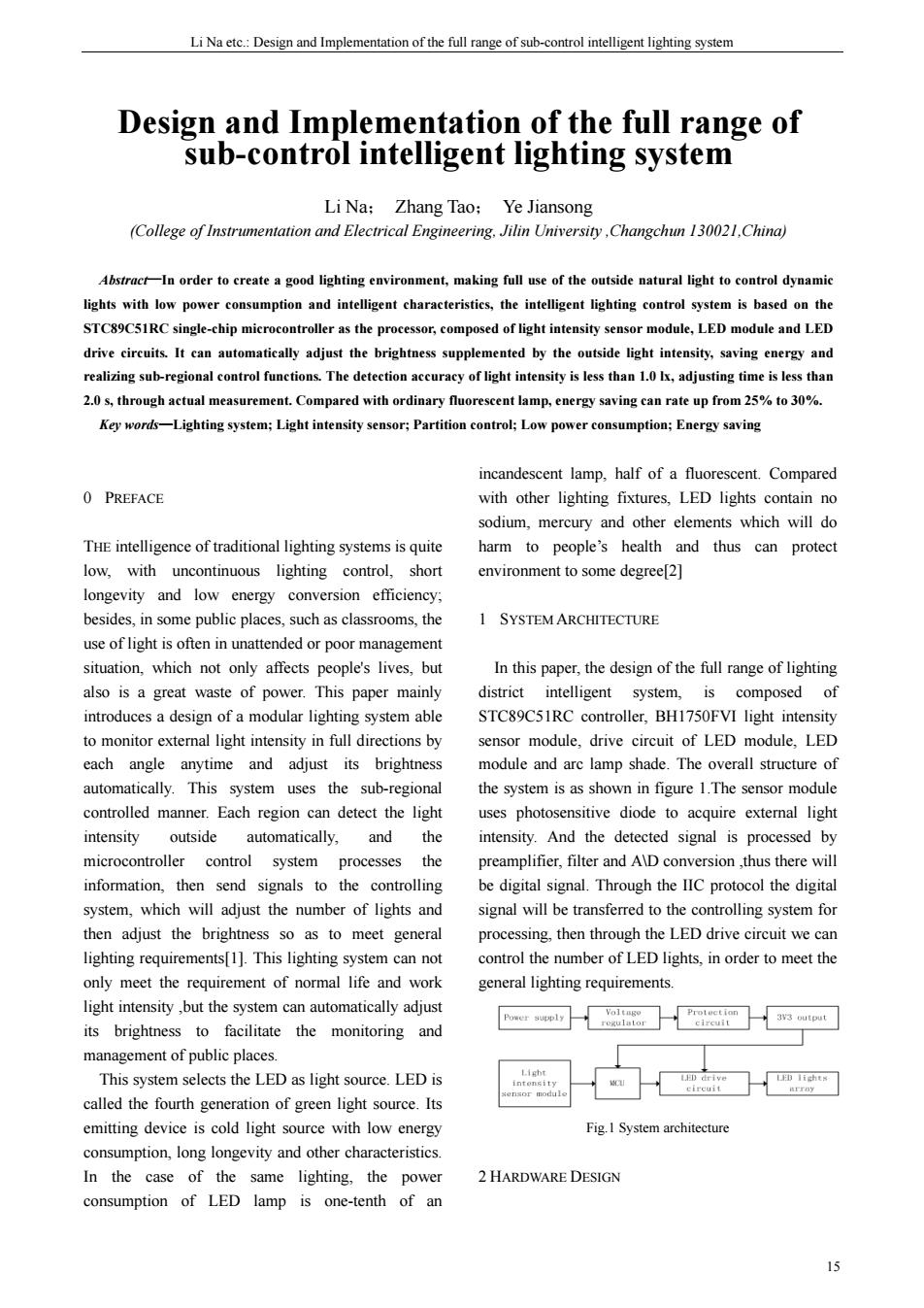正在加载图片...

LiNa et Design and Implementationof the full range of sub-control inteligent lighting system Design and Implementation of the full range of sub-control intelligent lighting system LiNa:Zhang Tao:Ye Jiansong (College of Instrumentation and Electrical Engineering.Jilin UniversityChangchun 130021.China) Abstract-In order to create a good lighting environment,making full use of the outside natural light to control dynamic STCC5IRC single-chip mie the of ight LED LED drive circuits.It can automatically adjust the brightness supplemented by the outside light intensity,saving energy and realizing sub-regional contro functions.The detection accuracy of light intensity is less than 1.0 adjusting time is less than 2.0s,through actual measurement.Compared with ordinary fuorescent lamp,energy saving can rate up from25%to30% key ords-Liehtine system:Light inteusity sensor:Partition control:low power consumption:Energy saving incandescent lamp,half of a fluorescent.Compared 0 PREFACE with other lighting fixtures,LED lights contain no sodium,mercury and other elements which will do THE intelligence of traditional lighting systems is quite harm to people's health and thus can protect with lighting control,short environment to some degree2] longevity and low energy conversion efficiency besides,in some public places,such as classrooms,the 1 SYSTEM ARCHITECTURE use of light is often in unattended or poor management situation.which not only affects people's lives.but In this paper,the design of the full range of lighting also isa great waste of power.This paper mainly district ntelligent system is introducesa design of a modular lighting system able to monitor extemal light intensity in full directions by sensor module,drive circuit of LED module.LED each angle anytime and adjust its brightness module and arc lamp shade.The overall structure of automatically.This system uses the sub-regional the system is as shown in figure 1.The sensor module controlled manner.Each region can detect the light uses photosensitive diode to acquire extemnal light intensity outside and the intensity.And the detected signal is processed by control system processes the preamplifier,filter and AlD conversionthus there will information,then send signals to the controlling be digital signal.Through the IIC protocol the digital system,which will adjust the number of lights and signal will be transferred to the controlling system for then adjust the brightness so as to meet general processing.then through the LED drive circuit we can This lighting n no ontro the number of LED lights,inorder to meet the only meet the requirement of normal life and work general lighting requirements light intensity but the system can automatically adjus its brightness to facilitate the monitoring and management of public places. This system selects the LED as light source.LED is called the fourth generation of gre light source.Its emitting device is cold light source with low energy consumption,long longevity and other characteristics. In the case of the same lighting.the power 2 HARDWARE DESIGN consumption of LED lamp is one-tenth of an 15Li Na etc.: Design and Implementation of the full range of sub-control intelligent lighting system 15 Design and Implementation of the full range of sub-control intelligent lighting system Li Na; Zhang Tao; Ye Jiansong (College of Instrumentation and Electrical Engineering, Jilin University ,Changchun 130021,China) Abstract—In order to create a good lighting environment, making full use of the outside natural light to control dynamic lights with low power consumption and intelligent characteristics, the intelligent lighting control system is based on the STC89C51RC single-chip microcontroller as the processor, composed of light intensity sensor module, LED module and LED drive circuits. It can automatically adjust the brightness supplemented by the outside light intensity, saving energy and realizing sub-regional control functions. The detection accuracy of light intensity is less than 1.0 lx, adjusting time is less than 2.0 s, through actual measurement. Compared with ordinary fluorescent lamp, energy saving can rate up from 25% to 30%. Key words—Lighting system; Light intensity sensor; Partition control; Low power consumption; Energy saving 0 PREFACE THE intelligence of traditional lighting systems is quite low, with uncontinuous lighting control, short longevity and low energy conversion efficiency; besides, in some public places, such as classrooms, the use of light is often in unattended or poor management situation, which not only affects people's lives, but also is a great waste of power. This paper mainly introduces a design of a modular lighting system able to monitor external light intensity in full directions by each angle anytime and adjust its brightness automatically. This system uses the sub-regional controlled manner. Each region can detect the light intensity outside automatically, and the microcontroller control system processes the information, then send signals to the controlling system, which will adjust the number of lights and then adjust the brightness so as to meet general lighting requirements[1]. This lighting system can not only meet the requirement of normal life and work light intensity ,but the system can automatically adjust its brightness to facilitate the monitoring and management of public places. This system selects the LED as light source. LED is called the fourth generation of green light source. Its emitting device is cold light source with low energy consumption, long longevity and other characteristics. In the case of the same lighting, the power consumption of LED lamp is one-tenth of an incandescent lamp, half of a fluorescent. Compared with other lighting fixtures, LED lights contain no sodium, mercury and other elements which will do harm to people’s health and thus can protect environment to some degree[2] 1 SYSTEM ARCHITECTURE In this paper, the design of the full range of lighting district intelligent system, is composed of STC89C51RC controller, BH1750FVI light intensity sensor module, drive circuit of LED module, LED module and arc lamp shade. The overall structure of the system is as shown in figure 1.The sensor module uses photosensitive diode to acquire external light intensity. And the detected signal is processed by preamplifier, filter and A\D conversion ,thus there will be digital signal. Through the IIC protocol the digital signal will be transferred to the controlling system for processing, then through the LED drive circuit we can control the number of LED lights, in order to meet the general lighting requirements. Fig.1 System architecture 2 HARDWARE DESIGN